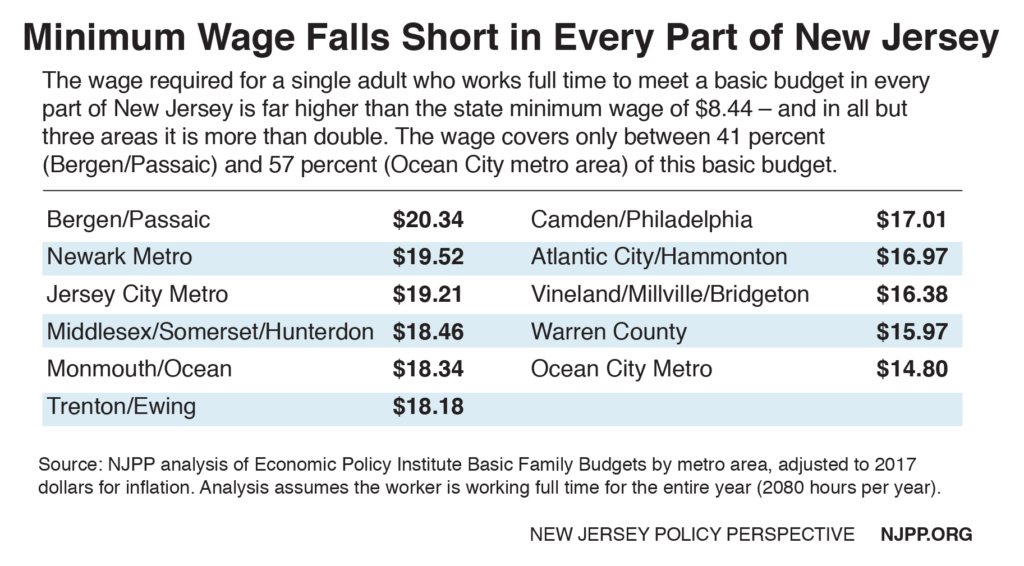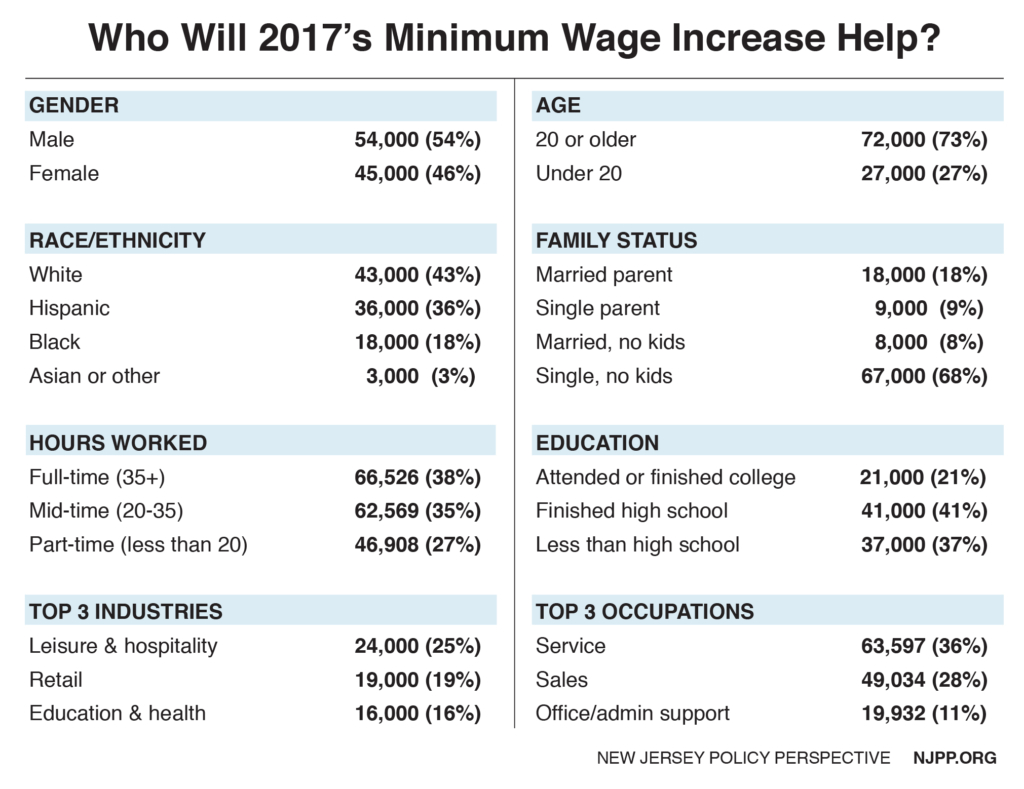To read a PDF version of this report, click here.
 On January 1, 2017, New Jersey’s minimum wage will rise by 0.7 percent to $8.44 per hour,[1] giving approximately 99,000 Garden State workers a very slight pay increase in the new year.
On January 1, 2017, New Jersey’s minimum wage will rise by 0.7 percent to $8.44 per hour,[1] giving approximately 99,000 Garden State workers a very slight pay increase in the new year.
To call this 6-cent wage increase “modest” would be a huge understatement. But the lifting of the wage floor is an important illustration of smart policy design and the power of “indexing” minimum wages. Without a minimum wage that was tied to rising costs of living, as New Jersey’s now is, these workers would see an even-worse decline in the purchasing power of their meager wages.
Policymakers were smart to include indexing in the 2013 wage increase, but there is clearly more work to be done to improve the economic security of the Garden State’s low-paid workers.
Unfortunately, efforts to boost the incomes of these lowest-paid workers, and the state’s economy, hit a dead end this year when Gov. Christie vetoed legislation that would have gradually raised the minimum wage to $15 an hour over the course of five years. With the stroke of his red pen, the governor blocked a sensible and modest raise for about 1 in 4 Garden State workers, or 975,000 men and women.[2] The wage increase would have helped a diverse group of workers who currently aren’t paid enough to make ends meet, improving their chances of getting by – and, for many, providing for their families – in high-cost New Jersey.
In contrast, the wage increase going into effect on January 1 will effect a much smaller portion – about 2.5 percent rather than 25 percent – of the state’s workforce, and have a much smaller impact on low-paid workers and their families, as well as the local economies that rely on these workers as customers.
Of the 99,000 workers affected by the wage increase, 98,000 are directly affected – meaning they currently make between $8.38 and $8.44 per hour – and the remaining 1,000 are indirectly affected – meaning they currently make between $8.44 and $8.50 per hour, and will see their pay increase as employer pay scales are adjusted upward to reflect the new minimum wage.[3]
Overall, these 99,000 workers will see an average annual wage increase of $402 in 2017. The increase for all affected workers will total $39.7 million in 2017.
While the 2017 increase in the state minimum wage is welcome news for New Jersey’s low-paid workers (think: a $7.73 average weekly increase), it is not a wage floor that allows workers to get by, much less climb into the middle class, in a high-cost state such as New Jersey.
In fact, the basic cost of living in 2017 for a single adult working full time requires an hourly wage between $14.80 in the Ocean City metro area and $20.34 in the Bergen-Passaic metro area – far above the 2017 minimum wage of $8.44 an hour. Adding one child to the mix for a single parent increases that benchmark to between $27.77 in the Ocean City metro area and $32.74 in the Bergen-Passaic metro area.[4]
This basic family budget, designed by the Economic Policy Institute, includes money for the major expenses of housing, food, transportation, health care, child care and taxes, as well as modest amounts for other necessary items like clothing, personal care items, school supplies, entertainment and household supplies. It does not include other typical expenditures of a middle-class family like weekend trips or savings of any kind.[5]
January 1 Increase Will Help a Diverse Group of Low-Paid Workers
A total of 99,000 low-wage New Jersey workers – or 2.5 percent of the state’s total workforce –will benefit from the coming minimum wage increase. Due to ongoing shifts in the nature of low-wage work in America, these workers are older, more educated and working more hours than they have been in decades – despite the insistence of minimum wage opponents that low-paid workers are primarily teenagers looking for extra cash.[6]
Of those affected, an overwhelming majority – 73 percent – are at least 20 years old, while about one in three – 32 percent – are at least 40 years old. Nearly half – 47 percent – are working full-time, and an additional 28 percent are working mid-time (between 20 and 35 hours per week). Only 25 percent are working part-time.
About one in four affected workers – 24 percent – have children, and 48,000 New Jersey kids have at least one parent who will see a pay boost in 2017.
Endnotes
[1] New Jersey Department of Labor and Workforce Development, Notice of Administrative Changes N.J.A.C. 12:56-3.1, September 2016,
[2] New Jersey Policy Perspective, Raising New Jersey’s Minimum Wage to $15 an Hour Would Boost a Large and Diverse Group of Working Men and Women, March 2016.
[3] All economic and demographic information in this report is from the Economic Policy Institute’s analysis of the Current Population Survey (CPS), Outgoing Rotation Group public use microdata from the fourth quarter of 2013 to the third quarter of 2014. The number of workers is estimated from the CPS respondents for whom either a valid hourly wage is reported or one can be imputed from weekly earnings and average weekly hours. Consequently, this estimate tends to understate the size of the full workforce. All figures are rounded for clarity and readability.
[4] NJPP analysis of Economic Policy Institute family budgets by metro area, adjusted to 2017 to account for inflation using projections for the Consumer Price Index from the Congressional Budget Office. Calculations assume each adult is working full-time for the entire year (2080 hours per adult).
[5] For more on how the family budgets are calculated, see: http://www.epi.org/resources/budget/
[6] For example, see: Center for Economic and Policy Research, Low-Wage Workers Are Older and Better-Educated Than Ever, April 2012.



